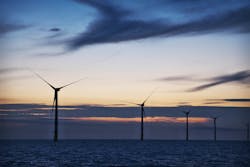Triton Knoll wind turbines installed offshore the UK
Cadeler’s jackup vessel Wind Osprey has installed the final turbine at RWE’s Triton Knoll offshore wind farm in the UK North Sea.
Located 32 km (20 mi) off the Lincolnshire coast, Triton Knoll consists of 90 Vestas 9.5-MW turbines, each one up to 187 m (614 ft) tall, with blades more than 80 m (262 ft) long.
Turbine installation began in January 2021. Turbine commissioning is expected to be completed this year. The project is expected to be completed in 2022. Once fully operational, Triton Knoll is expected to power more than 800,000 UK homes.
Triton Knoll generated its first power and delivered it to the grid in February 2021.
Triton Knoll is jointly owned by RWE (59%), J-Power (25%), and Kansai Electric Power (16%). RWE is leading both the wind farm’s construction and the long-term operation and maintenance works.
Total planned investment is estimated at £2 billion ($2.8 billion).
Financing in place for Vineyard Wind 1
Vineyard Wind, a joint venture between Avangrid Renewables and Copenhagen Infrastructure Partners, has reached financial close on the Vineyard Wind 1 project.
Working with nine international and US-based banks, $2.3 billion of senior debt has been raised to finance the construction of the project. This enables the company to provide a notice to proceed to its contractors in the coming days and weeks.
Vineyard Wind 1 is an 800-MW project that will be located 15 mi (24 km) offshore Martha’s Vineyard. It is expected to be the first commercial scale offshore wind project in the US.
Onshore work is expected to begin this fall in Barnstable, Massachusetts, with offshore work starting in 2022. First power is expected to be delivered to the grid in 2023.
According to the company, the project is expected to generate electricity for more than 400,000 homes and businesses in the Commonwealth of Massachusetts, save ratepayers $1.4 billion over the first 20 years of operation, and reduce carbon emissions by more than 1.6 million tons per year.
DNV issues guidance on wind farm design
DNV has published a new technical note providing principles for determining site extreme wind speeds for offshore wind farms caused by tropical cyclones.
The document is published after an extensive industry collaboration to increase transparency and to reduce uncertainty in the design of wind farms in emerging offshore wind markets such as Taiwan, Japan, Korea, and the US.
Kim Sandgaard-Mørk, executive vice president for Renewables Certification at DNV, said: “Especially for emerging offshore wind markets with ambitious roadmaps, tropical cyclone loads are of critical importance. Recent events like Hurricane Ida prove that wind farms need to be designed for these extreme local environmental conditions to support the plans to develop multi-megawatt offshore wind projects.”
The technical note Site extreme wind speeds due to tropical cyclones for wind power plants is a result of a global collaborative effort, with more than 20 wind industry leaders, including OEMs, project developers, designers, and experts from/Asia Pacific, Europe, and North America.
After 18 months of work, the ACE (Alleviating Cyclone and Earthquake Challenges for Wind farms) JIP gathered enough experiences from cross-industry players to align wind farm design principles for those extreme environmental conditions.
Marcus Klose, Head of Section for Steel Structures at DNV, said: “To grow offshore wind worldwide, the need to obtain reliable extreme wind speeds became urgent, as sufficient long-term wind speed measurements to estimate extreme wind speeds are hardly available onshore, and even less for offshore sites.
“A lack of standardized approaches combined with little industry experience leads to high uncertainty on site extreme wind speeds. This substantially impacts the reliability and economic feasibility of wind farm projects. All industry stakeholders acting in emerging markets in the Asia/Pacific region and the US will benefit from the guidance we give in our technical note as it will help to minimize cost, warranty and liability risks in wind farm projects.”
Final turbine in place at Moray East offshore wind farm
Fred. Olsen Windcarrier’s jackup vessel Blue Tern has installed the 100th and final turbine at for the Moray East wind farm in the North Sea, off northeast Scotland.
Developer Moray Offshore Windfarm East is a joint venture between Ocean Winds (56.6%) Diamond Green (33.4%) and CTG (10%).
According to Ocean Winds, itself a 50-50 joint venture between EDP Renewables and ENGIE, operations started at the wind farm from its first set of turbines in June, and output has since increased as more turbines have been systematically installed and commissioned.
Before the end of the year, Moray East should reach its full output of 950 MW, via the 100 9.5-MW capacity V164 turbines. Power will be generated at £57.50/MWhr ($79.51/MWhr), which according to Ocean Winds, is the lowest cost of any new renewable generation in operation.
About the Author
Bruce Beaubouef
Managing Editor
Bruce Beaubouef is Managing Editor for Offshore magazine. In that capacity, he plans and oversees content for the magazine; writes features on technologies and trends for the magazine; writes news updates for the website; creates and moderates topical webinars; and creates videos that focus on offshore oil and gas and renewable energies. Beaubouef has been in the oil and gas trade media for 25 years, starting out as Editor of Hart’s Pipeline Digest in 1998. From there, he went on to serve as Associate Editor for Pipe Line and Gas Industry for Gulf Publishing for four years before rejoining Hart Publications as Editor of PipeLine and Gas Technology in 2003. He joined Offshore magazine as Managing Editor in 2010, at that time owned by PennWell Corp. Beaubouef earned his Ph.D. at the University of Houston in 1997, and his dissertation was published in book form by Texas A&M University Press in September 2007 as The Strategic Petroleum Reserve: U.S. Energy Security and Oil Politics, 1975-2005.

